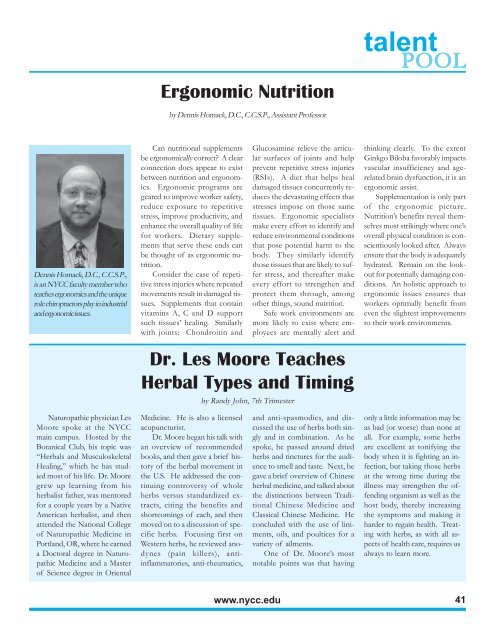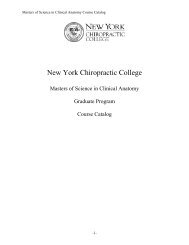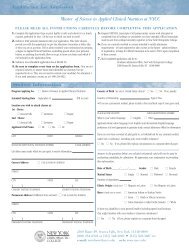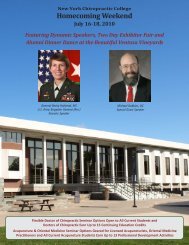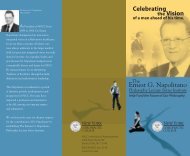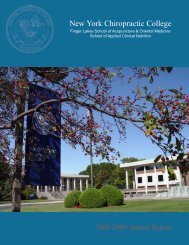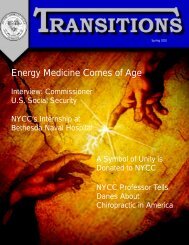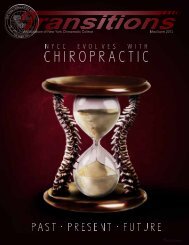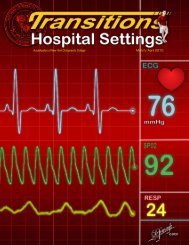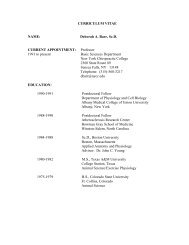2502 NYCC TRANS FINAL2 - New York Chiropractic College
2502 NYCC TRANS FINAL2 - New York Chiropractic College
2502 NYCC TRANS FINAL2 - New York Chiropractic College
Create successful ePaper yourself
Turn your PDF publications into a flip-book with our unique Google optimized e-Paper software.
Ergonomic Nutrition<br />
by Dennis Homack, D.C., C.C.S.P., Assistant Professor<br />
talent<br />
POOL<br />
Dennis Homack, D.C., C.C.S.P.,<br />
is an <strong>NYCC</strong> faculty member who<br />
teaches ergonomics and the unique<br />
role chiropractors play in industrial<br />
and ergonomic issues.<br />
Can nutritional supplements<br />
be ergonomically correct? A clear<br />
connection does appear to exist<br />
between nutrition and ergonomics.<br />
Ergonomic programs are<br />
geared to improve worker safety,<br />
reduce exposure to repetitive<br />
stress, improve productivity, and<br />
enhance the overall quality of life<br />
for workers. Dietary supplements<br />
that serve these ends can<br />
be thought of as ergonomic nutrition.<br />
Consider the case of repetitive<br />
stress injuries where repeated<br />
movements result in damaged tissues.<br />
Supplements that contain<br />
vitamins A, C and D support<br />
such tissues’ healing. Similarly<br />
with joints: Chondroitin and<br />
Glucosamine relieve the articular<br />
surfaces of joints and help<br />
prevent repetitive stress injuries<br />
(RSIs). A diet that helps heal<br />
damaged tissues concurrently reduces<br />
the devastating effects that<br />
stresses impose on those same<br />
tissues. Ergonomic specialists<br />
make every effort to identify and<br />
reduce environmental conditions<br />
that pose potential harm to the<br />
body. They similarly identify<br />
those tissues that are likely to suffer<br />
stress, and thereafter make<br />
every effort to strengthen and<br />
protect them through, among<br />
other things, sound nutrition.<br />
Safe work environments are<br />
more likely to exist where employees<br />
are mentally alert and<br />
Dr. Les Moore Teaches<br />
Herbal Types and Timing<br />
by Randy John, 7th Trimester<br />
thinking clearly. To the extent<br />
Ginkgo Biloba favorably impacts<br />
vascular insufficiency and agerelated<br />
brain dysfunction, it is an<br />
ergonomic assist.<br />
Supplementation is only part<br />
of the ergonomic picture.<br />
Nutrition’s benefits reveal themselves<br />
most strikingly where one’s<br />
overall physical condition is conscientiously<br />
looked after. Always<br />
ensure that the body is adequately<br />
hydrated. Remain on the lookout<br />
for potentially damaging conditions.<br />
An holistic approach to<br />
ergonomic issues ensures that<br />
workers optimally benefit from<br />
even the slightest improvements<br />
to their work environments.<br />
Naturopathic physician Les<br />
Moore spoke at the <strong>NYCC</strong><br />
main campus. Hosted by the<br />
Botanical Club, his topic was<br />
“Herbals and Musculoskeletal<br />
Healing,” which he has studied<br />
most of his life. Dr. Moore<br />
grew up learning from his<br />
herbalist father, was mentored<br />
for a couple years by a Native<br />
American herbalist, and then<br />
attended the National <strong>College</strong><br />
of Naturopathic Medicine in<br />
Portland, OR, where he earned<br />
a Doctoral degree in Naturopathic<br />
Medicine and a Master<br />
of Science degree in Oriental<br />
Medicine. He is also a licensed<br />
acupuncturist.<br />
Dr. Moore began his talk with<br />
an overview of recommended<br />
books, and then gave a brief history<br />
of the herbal movement in<br />
the U.S. He addressed the continuing<br />
controversy of whole<br />
herbs versus standardized extracts,<br />
citing the benefits and<br />
shortcomings of each, and then<br />
moved on to a discussion of specific<br />
herbs. Focusing first on<br />
Western herbs, he reviewed anodynes<br />
(pain killers), antiinflammatories,<br />
anti-rheumatics,<br />
and anti-spasmodics, and discussed<br />
the use of herbs both singly<br />
and in combination. As he<br />
spoke, he passed around dried<br />
herbs and tinctures for the audience<br />
to smell and taste. Next, he<br />
gave a brief overview of Chinese<br />
herbal medicine, and talked about<br />
the distinctions between Traditional<br />
Chinese Medicine and<br />
Classical Chinese Medicine. He<br />
concluded with the use of liniments,<br />
oils, and poultices for a<br />
variety of ailments.<br />
One of Dr. Moore’s most<br />
notable points was that having<br />
only a little information may be<br />
as bad (or worse) than none at<br />
all. For example, some herbs<br />
are excellent at tonifying the<br />
body when it is fighting an infection,<br />
but taking those herbs<br />
at the wrong time during the<br />
illness may strengthen the offending<br />
organism as well as the<br />
host body, thereby increasing<br />
the symptoms and making it<br />
harder to regain health. Treating<br />
with herbs, as with all aspects<br />
of health care, requires us<br />
always to learn more.<br />
www.nycc.edu<br />
41


